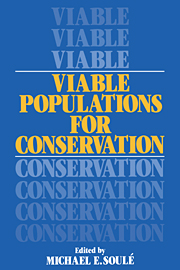Book contents
- Frontmatter
- Contents
- List of contributors
- Preface
- 1 Introduction
- 2 The demography of chance extinction
- 3 Extinction models and mammalian persistence
- 4 Minimum viable population size in the presence of catastrophes
- 5 Minimum viable populations: coping with uncertainty
- 6 Effective population size, genetic variation, and their use in population management
- 7 Spatial structure and population vulnerability
- 8 Managing critically endangered species: the Sumatran rhino as a case study
- 9 The role of interagency cooperation in managing for viable populations
- 10 Where do we go from here?
- Index
10 - Where do we go from here?
Published online by Cambridge University Press: 21 January 2010
- Frontmatter
- Contents
- List of contributors
- Preface
- 1 Introduction
- 2 The demography of chance extinction
- 3 Extinction models and mammalian persistence
- 4 Minimum viable population size in the presence of catastrophes
- 5 Minimum viable populations: coping with uncertainty
- 6 Effective population size, genetic variation, and their use in population management
- 7 Spatial structure and population vulnerability
- 8 Managing critically endangered species: the Sumatran rhino as a case study
- 9 The role of interagency cooperation in managing for viable populations
- 10 Where do we go from here?
- Index
Summary
The bottom line
Administrators, policy makers, and managers have a right to ask for the bottom line — in this context, the bottom line is the MVP for a ‘typical’ vertebrate. And biologists have the right and sometimes the obligation not to give an oversimplified, misleading answer to such a question (Soulé, 1986). Nevertheless, I think that scientists owe it to the rest of society to provide rules of thumb, even when they know that sometimes the rules will be misunderstood and misused.
Let's rephrase the question: When taking into account all of the relevant factors mentioned by the authors of this book, what is the lowest MVP that one might expect for a vertebrate? Here, I am assuming a 95% expectation of persistence, without loss of fitness, for several centuries. My guess is that it would be in the low thousands. The bases for this order of magnitude number are theory and observation (empirical biogeography). Regarding observation, there isn't a lot of data, but it appears that populations with carrying capacities much smaller than this don't persist for very long, except, perhaps, in very constant environments, and even then will lose most of their variation.
Newmark (1986) has shown that the most consistent predictor of persistence of mammalian species in western US national parks is estimated population size at the time of establishment of the parks (averaging about 75 years ago).
- Type
- Chapter
- Information
- Viable Populations for Conservation , pp. 175 - 184Publisher: Cambridge University PressPrint publication year: 1987
- 43
- Cited by



